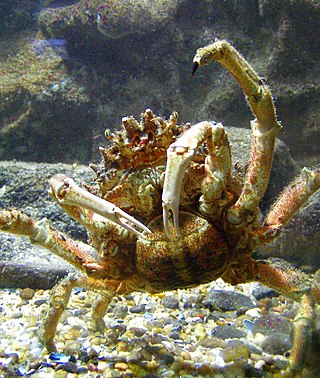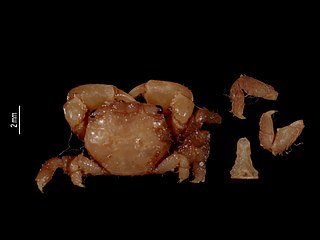
Ovalipes ocellatus, known as the lady crab, is a species of crab from eastern North America. Other names for it include the leopard crab or Atlantic leopard crab due to the leopard-like rosette patterns on its shell, the calico crab, or ocellated crab. It has a shell 3 in (7.6 cm) long and only slightly wider, which is covered in clusters of purple spots. It occurs from Canada to Georgia, and lives mainly on molluscs, such as the Atlantic surf clam.

Xanthidae is a family of crabs known as gorilla crabs, mud crabs, pebble crabs or rubble crabs. Xanthid crabs are often brightly coloured and are highly poisonous, containing toxins which are not destroyed by cooking and for which no antidote is known. The toxins are similar to the tetrodotoxin and saxitoxin produced by puffer fish, and may be produced by bacteria in the genus Vibrio living in symbiosis with the crabs, mostly V. alginolyticus and V. parahaemolyticus.

The Ocypodidae are a family of semiterrestrial crabs that includes the ghost crabs and fiddler crabs. They are found on tropical and temperate shorelines around the world.

Charybdis is a genus of swimming crabs in the family Portunidae. It is named after the monster Charybdis of Greek mythology.

Maja is a genus of majid crabs erected by Jean-Baptiste Lamarck in 1801. It includes the following extant species:

Cancridae is a family of crabs. It comprises six extant genera, and ten exclusively fossil genera, in two subfamilies:

Ovalipes catharus, commonly known as the paddle crab, swimming crab, or Māori: pāpaka, is a species of crab in the family Ovalipidae. They are found in shallow, sandy-bottomed waters around the coasts of New Zealand, the Chatham Islands, and uncommonly in southern Australia. They are opportunistic and versatile feeders active mostly at night, preying predominantly on molluscs and crustaceans. They are also highly prone to cannibalism both as part of their regular diet and as part of their mating behaviour. Their paddle-shaped rear legs and streamlined carapace allow them to swim rapidly to capture prey and to burrow in the sand in order to escape predation. Their mating season is in winter; the male carries the female until she moults, after which the two mate and the female moves into deeper waters to disperse her larvae.

Ovalipes australiensis is a species of crab found in southern Australia. Its range extends from Western Australia to Queensland, including Tasmania. It is fished commercially and recreationally, although it is not as important as the blue swimmer or mud crab.

Hexapodidae is a family of crabs, the only family in the superfamily Hexapodoidea. It has traditionally been treated as a subfamily of the family Goneplacidae, and was originally described as a subfamily of Pinnotheridae. Its members can be distinguished from all other true crabs by the reduction of the thorax, such that only seven sternites are exposed, and only four pairs of pereiopods are present. Not counting the enlarged pair of claws, this leaves only six walking legs, from which the type genus Hexapus, and therefore the whole family, takes its name. Some anomuran "crabs", such as porcelain crabs and king crabs also have only four visible pairs of legs. With the exception of Stevea williamsi, from Mexico, all the extant members are found either in the Indo-Pacific oceans, or around the coast of Africa.

Pilumnoidea is a superfamily of crabs, whose members were previously included in the Xanthoidea. The three families are unified by the free articulation of all the segments of the male crab's abdomen and by the form of the gonopods. The earliest fossils assigned to this group are of Eocene age.

Actumnus is a genus of crabs in the family Pilumnidae. Alongside the 28 extant species, it has a fossil record extending back into the Miocene.

Matutidae is a family of crabs, sometimes called moon crabs, adapted for swimming or digging. They differ from the swimming crabs of the family Portunidae in that all five pairs of legs are flattened, rather than just the last pair, as in Portunidae. Crabs in the Matutidae are aggressive predators.

Pseudomedaeus is a genus of crabs in the family Xanthidae, containing the following species:

Xanthias is a genus of crabs in the family Xanthidae, containing two exclusively fossil species and the following extant species:

Oregonia is a genus of crabs, comprising two extant species and one fossil species: It is classified in the family Oregoniidae under the spider crab superfamily Majoidea.

The Camptandriidae are a family of crabs, with 38 species in 21 genera:
William Stephenson MBE (1916–1996) was a British/Australian marine biologist and academic.

Trichia dromiaeformis is a crab that lives in the waters of the western Pacific, both the northern and southern hemisphere. It was described as Zalasius dromiaeformis by Mary J. Rathbun in 1897, and this name is still sometimes used. It was first described by De Haan in 1839. It is of the genus Trichia, and family Xanthidae. They are extremely camouflaged and live in sandy, muddy substrate. It grows shaggy hair on its dorsal side and the outside of its legs that resembles algae.

Ovalipes trimaculatus is a species of crab in the family Ovalipidae.


















